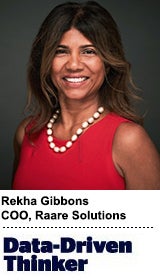“Data-Driven Thinking” is written by members of the media community and contains fresh ideas on the digital revolution in media.
Today’s column is written by Rekha Gibbons, Head of Multicultural Marketing & COO of Raare Solutions.
According to the US Census Bureau, by the year 2045, the minority population of America will become the majority. The historical white majority will be surpassed by minority segments of Black, Hispanic, Asian and multiracial groups. Brands who realize this paradigm shift can seize massive opportunities to engage with the “new face” of the American consumer.
And yet, even though one out of three consumers in America is multicultural, only 5.2% of marketing spend is directed toward them. This is despite forecasted spending power exceeding $1 trillion for Black, Hispanic and Asian populations.
How do brands navigate this impending shift in consumerism? For starters, acknowledge the opportunity. Improving cultural segmentation allows a brand to connect and communicate with consumers based on signal and behavior-based data.
Understand the power of your own data
Transforming your customer journey into a cultural journey starts with the power station of marketing data – the Customer Relationship Management (CRM) database. This repository contains the most valuable asset any brand can own: data about its own customers.
CRM data reveals a multidirectional, storytelling relationship between a customer and the brand. As the story unfolds, so do signals about the customer’s desires. Every touch point with the customer conveys nuances about the relationship, telling us how and when a customer wants to engage and what they want to see.
No skin tone forgotten: One brand that got it right is Fenty Beauty, Rihanna’s makeup line that launched in 2017. The inaugural video ad depicted a mesmerizing array of models, girls and women of every color. Rihanna’s mandate that every woman feel included in this brand rings true both in the product and messaging.
Women of color have been traditionally underrepresented in beauty campaigns, and Fenty proudly exhibited a different face, featuring its own skin tone for every one of the 40 shades of foundation, from black to white and all the hues in between.
Fenty Beauty became the biggest beauty brand launch in YouTube history. Sales surpassed estimations, crashing Fenty’s own DTC website. Consumer reactions were phenomenal, as evidenced by photos of lines forming outside the retail stores in 117 countries. Oh, and the first repost on social media was from a woman wearing a hijab.
Append owned and acquired data to amplify results
Owned data might be the brand’s most valuable asset, but it is finite. Expanding the target audience requires sourcing layers of contextual, behavioral and demographic data. This is data collected from various sources (social networks, websites) that may be owned or acquired (purchased from a third party).
While this may be perceived as an “old school” marketing move, it still makes sense. Acquired data offers information about prospects that exist outside of your brand that can help you enhance the customer experience.
Here are some approaches to acquired data that can enhance the customer experience:
- Data hygiene. Customer data ages and degrades rapidly in a world where people move, change jobs or abandon one email account for another. Hygiene sources match your customer data to external sources to update postal address, email and phone number.
- Demographic enhancement. Append services provide a form of second-party data (not owned by the brand, but data about known customers from an outside entity) to provide valuable insight, such as verification of ethnicity, gender, income, household, interests and even custom-built “in-market” signals that can help create more personalized experiences.
- Third-party data. Accessing customer data points, behavior and other data from outside parties can help you judiciously target potential audiences by modeling the behavior of large populations of consumers and creating look-alike models. This works with anonymous consumer data, and its longevity and accessibility in the marketing world remains in flux due to evolving privacy regulation.
Data science of diversity and inclusion
Cultural segmentation is the data science of diversity and inclusion. The 2045 majority shift is coming and heralds a monumental opportunity for brands to engage and impress with the new face of the consumer in meaningful and data-driven ways.
Follow AdExchanger (@AdExchanger) on Twitter.













